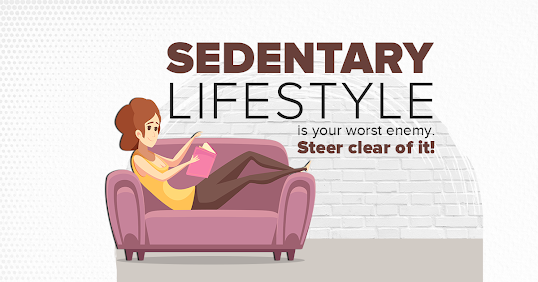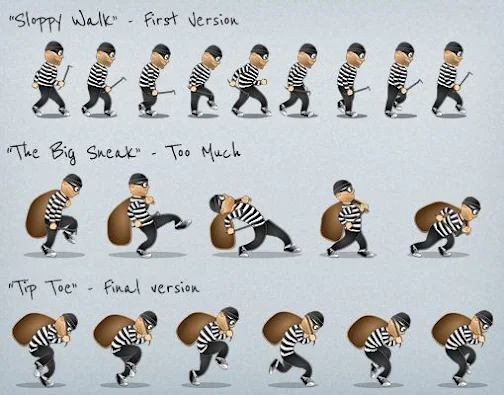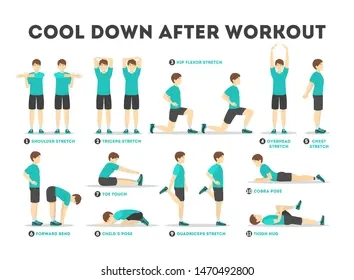Introduction
Little to no movement during the day is a sign of insufficient physical activity and is characteristic of Sedentary Lifestyle. Sedentary behaviors are often associated with watching TV, playing video games, reading, using computers or cellphones, or just relaxing while socializing. This lifestyle decision has a significant impact on health, raising the risk of contracting certain diseases and avoidable causes of death.
Studies show that people spend between 4.7 and 6.5 hours a day sitting, and that this percentage rises annually. One popular technique to gauge sedentary behavior is the quantity of time spent sitting. Obesity can result from a sedentary lifestyle since it raises body mass index (BMI). Thus, obesity raises the risk of developing a number of illnesses as well as early death.
Indirectly, a Sedentary Lifestyle can impact productivity and absenteeism. Increased BMI resulting from inactivity may lead to decreased efficiency in daily tasks and contribute to more frequent absences from work or other necessary activities.
Long periods of sitting have been linked to health concerns, regardless of BMI or physical activity, according to research. Individuals who sit for longer than five hours a day are more likely to suffer from health issues than those who don't spend as much time sitting down. Nevertheless, regular physical activity, such as four hours or more per week, can mitigate some of these risks.
Understanding Sedentary Lifestyles:
Sedentary Lifestyles encompass various activities that involve prolonged sitting or reclining, such as watching television, using electronic devices, driving, or working at desks for long hours. With the advent of modern conveniences and digital technologies, sedentary behaviors have become increasingly prevalent, affecting individuals of all ages and backgrounds.
The Impact of Sedentary Lifestyles:
Our modern world often encourages a Sedentary Lifestyle - think office jobs, commutes by car, and hours spent relaxing in front of screens. While it may seem comfortable, this lack of physical activity has a significant negative impact on our health.
Our cardiovascular systems are also strained by Sedentary Lifestyles. Frequent exercise strengthens the heart and enhances blood flow. Without it, our risk of high blood pressure, heart disease, and stroke increases.
The impact goes beyond physical health. According to studies, inactivity can weaken bones and muscles, raising the possibility of fractures and diseases like osteoporosis. Sedentary Lifestyles have also been connected to mental health conditions like anxiety and depression.
The good news is that significant effects can be achieved with minor adjustments. Taking little walks or stretching in between long stretches might significantly improve your health. Try to fit regular physical activity into your daily schedule, whether it's a quick stroll, a bike ride, or an exercise class. Keep in mind that any action is preferable to none. By adopting a more active lifestyle, you can reduce your risk of chronic diseases, improve your mental well-being, and feel stronger and more energized overall. Take control of your health and make a move towards a healthier you!
The Detriments of Sedentary Habits
Additionally detrimental to general wellbeing and mental health are sedentary habits. Stress, anxiety, sadness, and social isolation have all been linked to Sedentary Lifestyles and excessive screen use. Apart from restricting chances for interpersonal interaction, leisure in nature, and physical activity, the sedentary nature of numerous contemporary pursuits intensifies mental health problems.
The Economic Burden of Sedentary Lifestyles:
In addition to having a detrimental impact on people's health, sedentary habits are very expensive for society and the healthcare system. The direct healthcare costs associated with treating obesity, cardiovascular disease, and other illnesses associated with Sedentary Lifestyles are enormous. Moreover, the economic effects of sedentary behavior are further exacerbated by productivity losses brought on by presenteeism, absenteeism, and poor job efficiency.
Addressing the Challenge:
Combatting the rising prevalence of Sedentary Lifestyles requires a multifaceted approach involving individuals, communities, policymakers, and healthcare professionals. Education and awareness campaigns play a crucial role in informing the public about the risks of sedentary behavior and promoting the importance of regular physical activity.
Employers have a responsibility to create conducive work environments that prioritize employee health and well-being. This may include implementing ergonomic workstations, encouraging active breaks, promoting standing meetings, and providing incentives for physical activity.
Urban planning and transportation policies should prioritize pedestrian-friendly infrastructure, public parks, and recreational facilities to facilitate active lifestyles. Encouraging walking, cycling, and public transit can help reduce reliance on sedentary modes of transportation such as driving.
Technology can also be utilized to promote physical activity and deter sedentary behavior. Fitness applications, wearable technologies, and gamification strategies can all motivate users to track their activity levels and exercise frequently. Furthermore, telecommuting choices and workplace health initiatives can give workers more freedom to fit exercise into their everyday schedules.
Community-based interventions, such as walking groups, exercise classes, and sports leagues, provide opportunities for social engagement and physical activity. Schools play a critical role in promoting active lifestyles among children and adolescents through physical education programs, sports participation, and recess activities.
Policy initiatives aimed at reducing sedentary behavior may include implementing workplace wellness regulations, restricting screen time for children, incentivizing physical activity through tax incentives or subsidies, and integrating physical activity guidelines into healthcare protocols.
- Specific Health Risks: You could delve deeper into specific health risks associated with a Sedentary Lifestyle. This could include detailed explanations of how inactivity contributes to diabetes, heart disease, certain cancers, and musculoskeletal disorders.
- Focus on Different Age Groups: Explore how Sedentary Lifestyles affect different age groups, like children, working adults, and older adults. Each group might have unique challenges and solutions.
- Benefits of Exercise: Provide a section on the positive impacts of regular exercise. This could cover improved mood, cognitive function, sleep quality, and immune system strength.
- Examples of Movement throughout the Day: Offer practical tips for incorporating more movement into daily routines. Include examples like taking the stairs, parking further away, using a standing desk, or short walking breaks.
- Success Stories: Feature success stories of individuals who overcame a Sedentary Lifestyle. This can motivate readers and provide a sense of achievability.
These are just a few ideas to expand on the existing content. I hope they help!
Move It or Lose It: Small Steps for Big Health Gains
As everyone knows, leading a Sedentary Lifestyle carries risks, including a higher chance of developing chronic illnesses, less energy, and even mental health issues. The good news is that you can still benefit from movement without completely changing your life. Throughout the day, little adjustments can have a significant impact.
The Power of NEAT:
Activities Without Exercise We call this process thermogenesis, or NEAT. It's anything you do—like pacing, climbing stairs, fidgeting, or doing housework—that isn't intended for an exercise program. NEAT adds up throughout the day, despite not burning a lot of calories on its own. Increasing your NEAT can have a significant positive effect on your health even if you don't have time for a regular exercise routine.
Sneaky Ways to Sneak in Movement:
Here are some easy ways to incorporate more NEAT into your daily life:
- Become a Standing Citizen: Trade your office chair for a standing desk, or alternate sitting and standing throughout the day.
- Take the Scenic Route: Park further away from your destination or take the stairs whenever possible.
- Deskercise: Find simple exercises you can do at your desk, like leg lifts, arm circles, or stretches.
- The Commercial Break Workout: During TV commercials, get up and do some jumping jacks, squats, or lunges.
- Step it Up: Invest in a pedometer and set a daily step goal. Start small and gradually increase your steps daily.
- The Power of Play: Take a midday break to play an active game with your colleagues, walk the dog, or shoot some hoops.
Beyond the Basics:
While NEAT is a great place to start, aiming for at least 30 minutes of moderate-intensity exercise most days of the week is ideal. This could be anything you enjoy, like brisk walking, swimming, cycling, dancing, or team sports.
Find Your Fun:
The key to sticking with any exercise program is finding activities you actually enjoy. Explore different options until you discover something that keeps you motivated.
Make it a Habit:
Just like any new habit, incorporating movement takes consistency. Schedule your workouts in your calendar, find an exercise buddy, or track your progress to stay accountable.
Remember, even small changes can make a big difference. Start gradually, listen to your body, and find ways to make movement a natural part of your day. Your body and mind will thank you for it!
Deskbound to Delightful: Workouts for the Busy Office WorkerThe new smoking is sitting! There's no doubting the detrimental effects of a sedentary office job on one's health, even though this adage may be a little exaggerated. Among the main problems experienced by desk-bound workers are back pain, tight muscles, and lethargy.
But fear not, there's hope! Here are some creative and practical workouts specifically designed to combat the perils of a prolonged sitting posture and get your blood pumping throughout the workday:
The 5-Minute Fix:
Short on time? No problem! This quick routine can be done right at your desk in just 5 minutes:
- Neck Rolls: Gently roll your head in a circular motion, 5 times forward and 5 times backward. Repeat 2 times.
- Shoulder Shrugs: Raise your shoulders towards your ears, hold for a count of 2, then release. Repeat 10 times.
- Arm Circles: Make small circles with your arms, forward 10 times and backward 10 times.
- Ankle Pumps: Lift your heels off the ground, hold for a count of 2, then lower. Repeat 10 times on each foot.
- The Wall Sit: Stand with your back flat against the wall, slowly slide down until your thighs are parallel to the floor. Hold for 30 seconds, then slowly stand back up.
The Midday Stretch:
Feeling tight and stiff after lunch? This energizing stretch routine will help loosen you up:
- Standing Cat-Cow: Start on all fours, arch your back upwards as you look towards the ceiling (cow pose). Then, round your back and tuck your chin to your chest (cat pose). Repeat 10 times.
- Sitting on the floor with your feet flat on the floor and one leg extended and the other bent is a good way to stretch your hamstrings. Bend forward toward your outstretched leg and reach for your toes, or as far as is reasonably practicable. After 30 seconds of holding, switch to the other side.
- Chest Opener: Stand in a doorway with your forearms on either side of the doorframe. Lean forward gently, stretching your chest muscles. Hold for 30 seconds.
The Energizer Bunny:
Looking for a way to boost your energy levels in the afternoon slump? This quick cardio burst will get your heart rate up:
- Jumping Jacks: Get your heart pumping with 30 seconds of classic jumping jacks.
- High Knees: Run in place while bringing your knees high towards your chest for 30 seconds.
- Butt Kicks: Run in place while kicking your heels towards your glutes for 30 seconds.
Bonus Tip: Invest in a resistance band! These versatile tools can be used for a variety of exercises that target different muscle groups, all while remaining compact and easy to store at your desk.
Remember, consistency is key! Try to take a few minutes each hour to get up and move around. These are but a handful of suggestions to get you going. For a healthier, happier you, figure out what makes the most sense for you and include activity to your workday!
The new smoking is sitting! There's no doubting the detrimental effects of a sedentary office job on one's health, even though this adage may be a little exaggerated. Among the main problems experienced by desk-bound workers are back pain, tight muscles, and lethargy.
But fear not, there's hope! Here are some creative and practical workouts specifically designed to combat the perils of a prolonged sitting posture and get your blood pumping throughout the workday:
The 5-Minute Fix:
Short on time? No problem! This quick routine can be done right at your desk in just 5 minutes:
- Neck Rolls: Gently roll your head in a circular motion, 5 times forward and 5 times backward. Repeat 2 times.
- Shoulder Shrugs: Raise your shoulders towards your ears, hold for a count of 2, then release. Repeat 10 times.
- Arm Circles: Make small circles with your arms, forward 10 times and backward 10 times.
- Ankle Pumps: Lift your heels off the ground, hold for a count of 2, then lower. Repeat 10 times on each foot.
- The Wall Sit: Stand with your back flat against the wall, slowly slide down until your thighs are parallel to the floor. Hold for 30 seconds, then slowly stand back up.
The Midday Stretch:
Feeling tight and stiff after lunch? This energizing stretch routine will help loosen you up:
- Standing Cat-Cow: Start on all fours, arch your back upwards as you look towards the ceiling (cow pose). Then, round your back and tuck your chin to your chest (cat pose). Repeat 10 times.
- Sitting on the floor with your feet flat on the floor and one leg extended and the other bent is a good way to stretch your hamstrings. Bend forward toward your outstretched leg and reach for your toes, or as far as is reasonably practicable. After 30 seconds of holding, switch to the other side.
- Chest Opener: Stand in a doorway with your forearms on either side of the doorframe. Lean forward gently, stretching your chest muscles. Hold for 30 seconds.
The Energizer Bunny:
Looking for a way to boost your energy levels in the afternoon slump? This quick cardio burst will get your heart rate up:
- Jumping Jacks: Get your heart pumping with 30 seconds of classic jumping jacks.
- High Knees: Run in place while bringing your knees high towards your chest for 30 seconds.
- Butt Kicks: Run in place while kicking your heels towards your glutes for 30 seconds.
Bonus Tip: Invest in a resistance band! These versatile tools can be used for a variety of exercises that target different muscle groups, all while remaining compact and easy to store at your desk.
Remember, consistency is key! Try to take a few minutes each hour to get up and move around. These are but a handful of suggestions to get you going. For a healthier, happier you, figure out what makes the most sense for you and include activity to your workday!
Conclusion:
In conclusion, Sedentary Lifestyles pose an increasing and widespread threat to people's health, happiness, and productivity in both individual and global society. To tackle this problem, multiple stakeholders must work together to encourage physical exercise, decrease prolonged sitting, and design spaces that encourage active lives. We can lessen the negative consequences of sedentary behavior and promote healthier, more active societies for future generations by increasing awareness, putting evidence-based solutions into practice, and lobbying for legislative reforms.

.png)
.jpg)
.jpg)


Comments
Post a Comment